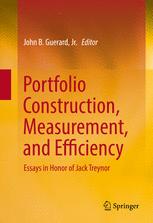

Most ebook files are in PDF format, so you can easily read them using various software such as Foxit Reader or directly on the Google Chrome browser.
Some ebook files are released by publishers in other formats such as .awz, .mobi, .epub, .fb2, etc. You may need to install specific software to read these formats on mobile/PC, such as Calibre.
Please read the tutorial at this link: https://ebookbell.com/faq
We offer FREE conversion to the popular formats you request; however, this may take some time. Therefore, right after payment, please email us, and we will try to provide the service as quickly as possible.
For some exceptional file formats or broken links (if any), please refrain from opening any disputes. Instead, email us first, and we will try to assist within a maximum of 6 hours.
EbookBell Team

0.0
0 reviewsThis volume, inspired by and dedicated to the work of pioneering investment analyst, Jack Treynor, addresses the issues of portfolio risk and return and how investment portfolios are measured. In a career spanning over fifty years, the primary questions addressed by Jack Treynor were: Is there an observable risk-return trade-off? How can stock selection models be integrated with risk models to enhance client returns? Do managed portfolios earn positive, and statistically significant, excess returns and can mutual fund managers time the market?
Since the publication of a pair of seminal Harvard Business Review articles in the mid-1960’s, Jack Treynor has developed thinking that has greatly influenced security selection, portfolio construction and measurement, and market efficiency. Key publications addressed such topics as the Capital Asset Pricing Model and stock selection modeling and integration with risk models. Treynor also served as editor of the Financial Analysts Journal, through which he wrote many columns across a wide spectrum of topics.
This volume showcases original essays by leading researchers and practitioners exploring the topics that have interested Treynor while applying the most current methodologies. Such topics include the origins of portfolio theory, market timing, and portfolio construction in equity markets. The result not only reinforces Treynor’s lasting contributions to the field but suggests new areas for research and analysis.